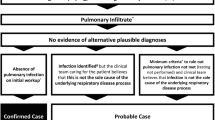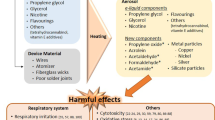Abstract
Secondhand smoke (SHS) accounts for 0.9 million deaths and 24 million disability adjusted life years (DALYs) annually. Nearly 30% of adults in India are exposed to SHS in India. To reduce SHS exposure, India enacted a smoke-free law in 2003 under which smoking in public places is banned. However, the compliance to this law has been variable in several assessments in the country. A better understanding of the nature and extent of SHS exposure can help inform better implementation of national smoke-free policies. The Global Adult Tobacco Survey (GATS) India 2016–17 collects information on the self-reported prevalence of SHS exposure in homes, workplaces, government buildings, restaurants, public transportation and health care facilities among adults (> 15 years of age).The present study utilized the GATS India 2016–17 dataset to provide estimates of SHS exposure among adults in India in homes, workplace and other public places, across gender and age groups and among the overall population and non-smokers. Weighted analysis was carried out. In the overall population, exposure to SHS in the home was 29.2%, more among young females. In workplaces, exposure to SHS was 29.2% overall, significantly higher among males (32.5%) compared to females (17.8%). In public buildings such as health care facilities and government offices, SHS exposure was less with 15.6% and 21.2% respectively. SHS exposure was high in restaurants with 39.3% overall, significantly higher among males (43.2%) compared to females (22.2%). Similar results were also seen among non-smokers. A large proportion of adults in India, both smokers and non-smokers are exposed to SHS in their homes, workplaces and other public places, especially restaurants, workplaces and public transportation. Females are more exposed to SHS at home, whereas males are more exposed in public places including workplaces. High SHS exposure among youths is also a concern. Stricter enforcement of legislation is required to ensure 100% smoke-free homes, public places and workplaces and reduce SHS exposure.

Similar content being viewed by others
References
Abdullah AS, Driezen P, Sansone G, Nargis N, Hussain GA, Quah AC, Fong GT (2014) Correlates of exposure to secondhand smoke (SHS) at home among non-smoking adults in Bangladesh: findings from the ITC Bangladesh survey. BMC Pulm Med 14:117. https://doi.org/10.1186/1471-2466-14-117
Agrawal D, Aggarwal A, Goel S (2015) Women exposed to second-hand smoke more at home than at workplace: an analysis of GATS report, India, 2009-10. J Fam Med Prim Care 4:293. https://doi.org/10.4103/2249-4863.161300
Azagba S (2015) Effect of smoke-free patio policy of restaurants and bars on exposure to second-hand smoke. Prev Med (Baltim) 76:74–78. https://doi.org/10.1016/j.ypmed.2015.04.012
Bhatt G, Goel S, Mor S, Gupta R (2018) Exposure to second hand smoke and its correlates in Northern State of India. Indian J Public Health 62:128–132. https://doi.org/10.4103/ijph.IJPH_442_16
Collaborators GBD 2016 Risk Factors Emmanuela, Afshin A, Abajobir AA et al (2017) Global, regional, and national comparative risk assessment of 84 behavioural, environmental and occupational, and metabolic risks or clusters of risks, 1990-2016: a systematic analysis for the Global Burden of Disease Study 2016. Lancet 390:1345–1422. https://doi.org/10.1016/S0140-6736(17)32366-8
Crémieux PY, Ouellette P (2001) Actual and perceived impacts of tobacco regulation on restaurants and firms. Tob Control 10:33–37. https://doi.org/10.1136/TC.10.1.33
Dogar OF, Pillai N, Safdar N et al (2015) Second-hand smoke and the risk of tuberculosis: a systematic review and a meta-analysis. Epidemiol Infect 143:3158–3172
Drago G, Perrino C, Canepari S, Ruggieri S, L'Abbate L, Longo V, Colombo P, Frasca D, Balzan M, Cuttitta G, Scaccianoce G, Piva G, Bucchieri S, Melis M, Viegi G, Cibella F, RESPIRA Collaborative Project Group, Indoor and Outdoor Air Quality and Respiratory Health in Malta and Sicily - RESPIRA Study Group, Balzan M, Bilocca D, Borg C, Montefort S, Zammit C, Bucchieri S, Cibella F, Colombo P, Cuttitta G, Drago G, Ferrante G, L'Abbate L, Grutta S, Longo V, Melis MR, Ruggieri S, Viegi G, Minardi R, Piva G, Ristagno R, Rizzo G, Scaccianoce G (2018) Relationship between domestic smoking and metals and rare earth elements concentration in indoor PM 2.5. Environ Res 165:71–80. https://doi.org/10.1016/j.envres.2018.03.026
Drope J, Schluger N, Cahn Z, Drope J, Hamill S, Islami F, et al. (2018) The Tobacco Atlas Sixth Edition. American Cancer Society and Vital Strategies, Atlanta.
Fong GT, Hyland A, Borland R et al (2006) Reductions in tobacco smoke pollution and increases in support for smoke-free public places following the implementation of comprehensive smoke-free workplace legislation in the Republic of Ireland: findings from the ITC Ireland/UK Survey. Tob Control 15:iii51–iii58. https://doi.org/10.1136/tc.2005.013649
GTSS Collaborative Group (2006) A cross country comparison of exposure to secondhand smoke among youth. Tob Control 15(Suppl 2):ii4–i19. https://doi.org/10.1136/tc.2006.015685
Hammar H (2004) Restaurant owner perceptions of the effects of a smoking ban. Health Policy (New York) 70:243–254. https://doi.org/10.1016/j.healthpol.2004.04.003
Hitchman SC, Fong GT (2011) Gender empowerment and female-to-male smoking prevalence ratios. Bull World Health Organ 89:195–202. https://doi.org/10.2471/BLT.10.079905
Institute for Health Metrics and Evaluation University of Washington (2019) Global Burden of Disease Compare Viz Hub. https://vizhub.healthdata.org/gbd-compare/. Accessed 4 Dec 2019
International Institute for Population Sciences and Ministry of Health and Family Welfare (2010) Global Adult Tobacco Survey India 2009–10
Khaiwal R, Tripathy JP, Tripathy NK (2016) Dynamics of multi-stakeholder engagement and its role in achieving high compliance of a tobacco control programme. World Dev Perspect 3:7–11. https://doi.org/10.1016/J.WDP.2016.10.002
King BA, Mirza SA, Babb SD, GATS Collaborating Group (2013) A cross-country comparison of secondhand smoke exposure among adults: findings from the Global Adult Tobacco Survey (GATS). Tob Control 22:e5. https://doi.org/10.1136/tobaccocontrol-2012-050582
Kumar R, Goel S, Harries AD, Lal P, Singh RJ, Kumar AM, Wilson NC (2014) How good is compliance with smoke-free legislation in India? Results of 38 subnational surveys. Int Health 6:189–195. https://doi.org/10.1093/inthealth/ihu028
Lee B-E, Ha E-H (2011) Exposure to environmental tobacco smoke among South Korean adults: a cross-sectional study of the 2005 Korea National Health and Nutrition Examination Survey. Environ Health 10:29. https://doi.org/10.1186/1476-069X-10-29
Max W, Sung H-Y, Shi Y (2009) Who is exposed to secondhand smoke? Self-reported and serum cotinine measured exposure in the U.S., 1999-2006. Int J Environ Res Public Health 6:1633–1648. https://doi.org/10.3390/ijerph6051633
Öberg M, Jaakkola MS, Woodward A et al (2011) Worldwide burden of disease from exposure to second-hand smoke: a retrospective analysis of data from 192 countries. Lancet 377:139–146. https://doi.org/10.1016/S0140-6736(10)61388-8
Reddy M, Kanungo S, Kar S (2018) Correlates of secondhand smoke exposure among nonsmoking youth (15–24 years) in India: secondary analysis from Global Adult Tobacco Survey, 2009–10. J Fam Med Prim Care 7:111–117. https://doi.org/10.4103/jfmpc.jfmpc_409_16
Schönherr E (1928) Contribution to the statistical and clinical features of lung tumours. Z Krebsforsch 27:436–450. https://doi.org/10.1007/BF02125480
Sein A, Than Htike M, Sinha D, Kyaing N (2012) Exposure to second-hand tobacco smoke among adults in Myanmar. Indian J Cancer 49:410–418. https://doi.org/10.4103/0019-509X.107749
Semple S, Maccalman L, Naji AA et al (2007) Bar workers’ exposure to second-hand smoke: the effect of Scottish smoke-free legislation on occupational exposure. Ann Occup Hyg 51:571–580. https://doi.org/10.1093/annhyg/mem044
Tata Institute of Social Sciences (TISS) and Ministry of Health and Family Welfare (2017) Global Adult Tobacco Survey GATS 2 India 2016–17. https://ntcp.nhp.gov.in/assets/document/surveys-reports-publications/Global-Adult-Tobacco-Survey-India-2009-2010-Report.pdf
United States. Public Health Service. Office on Smoking and Health (1986) The health consequences of involuntary smoking: a report of the surgeon general. DHHS publication no. (CDC) 87-8398. Washington DC, USA
Winickoff JP, Gottlieb M, Mello MM (2010) Regulation of smoking in public housing. N Engl J Med 362:2319–2325. https://doi.org/10.1056/NEJMhle1000941
World Health Organization (1999) International consultation on environmental tobacco smoke (ETS) and child health, 1999, Geneva, Switzerland. http://apps.who.int/iris/handle/10665/65930. Accessed 2 Oct 2018
World Health Organization (2005) WHO Framework Convention on Tobacco Control (WHO FCTC), Geneva, Switzerland.
World Health Organization and International Agency for Research on Cancer (2004) IARC Monographs on the Evaluation of Carcinogenic Risks to Humans Volume 83 Tobacco Smoke and Involuntary Smoking. Lyon, France
Author information
Authors and Affiliations
Corresponding author
Ethics declarations
As the study involved secondary analysis of GATS dataset which is in public domain, informed consent was waived off by The Union Ethics Advisory Group, Paris, France.
Conflict of interest
The authors declare that they have no conflict of interest.
Additional information
Responsible editor: Philippe Garrigues
Publisher’s note
Springer Nature remains neutral with regard to jurisdictional claims in published maps and institutional affiliations.
Rights and permissions
About this article
Cite this article
Tripathy, J.P. Secondhand smoke exposure at home and public places among smokers and non-smokers in India: findings from the Global Adult Tobacco Survey 2016–17. Environ Sci Pollut Res 27, 6033–6041 (2020). https://doi.org/10.1007/s11356-019-07341-x
Received:
Accepted:
Published:
Issue Date:
DOI: https://doi.org/10.1007/s11356-019-07341-x




